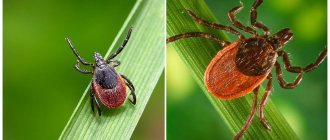The risk of contracting tick-borne encephalitis while in a tick habitat remains throughout the warm period of the year, but the likelihood of getting bitten by an infected tick is much higher in endemic regions. Let's find out which regions of the Russian Federation are endemic for tick-borne encephalitis, and which of them are the most dangerous during the period of tick activity.
An area endemic for tick-borne encephalitis is an area in whose ecosystem the causative agent of tick-borne encephalitis is constantly present, and almost every season there are cases of encephalitis in people bitten by ticks in this region.
The carriers of encephalitis are ixodid ticks. The endemicity of a region is formed as follows: ticks and warm-blooded animals living in this region regularly become infected with the virus from each other and become carriers of the disease. In this case, neither ticks nor animals die from encephalitis, but are only intermediate hosts of the virus.
This virus simply exists in their bodies and is passed on from generation to generation. But if an infected tick bites a person, the person in most cases becomes seriously ill. The tick can also infect farm animals, such as cows. If a person drinks milk from an infected cow, he will also get encephalitis.
How much higher is the likelihood of infection in an endemic area?
The risk of contracting tick-borne encephalitis in an endemic area is much higher than the average throughout the entire habitat of ixodid ticks. From 2 to 10% of ticks are carriers of the dangerous virus. Despite the measures taken, up to several dozen cases of tick-borne encephalitis are recorded per season, and some cases are fatal.
How does infection occur?
Tick-borne encephalitis is a seasonal disease. For Ixodes Persulcatus, the period of activity is May and June. And Ixodes Ricinus is characterized by two peaks per season - the beginning and end of summer, that is, May, June and August, September.
These are periods of active work on agricultural land, gardens and personal plots. In spring and summer, the movements of tourists relaxing in the lap of nature become more active. Even a walk in an urban area through a park or alley can lead to tick bites. Once on the skin, the arthropod makes a small incision, generously moistening it with saliva, and injects an anesthetic. More than 10 hours may pass from the moment of suction to the appearance of unpleasant sensations.
The incubation period averages 1–2 weeks. In the febrile form, the disease begins acutely and resembles the flu. The victim complains of hyperthermia (high body temperature), painful headaches, nausea, and vomiting.
A complicated course and unfavorable prognosis are characteristic of the meningeal and encephalitic (focal) forms. The viral infection has a toxic effect on the central and peripheral nervous system and is complicated by paralysis of the limbs. In 1–3% of patients, the disease becomes chronic. Mortality figures depend on the strain and range from 2% for the European form to 20% for the Far Eastern form.
The most dangerous regions of Russia for tick-borne encephalitis
Traditionally, the most dangerous areas for the likelihood of encephalitis are considered to be:
- Siberia;
- Ural;
- Far East.
Here are the main foci of tick-borne encephalitis, but cases of disease are also common in the middle zone, the Volga region and in the north-west of Russia. Endemic areas within all these zones are located unevenly: there are relatively favorable and extremely dangerous areas, delineated by climatic zones or landscape features.
What is tick-borne encephalitis
This is an acute viral infection. It has a natural focal nature, since a person becomes infected from an insect or animal.
The main mechanism of transmission of the pathogen in tick-borne encephalitis is transmissible. Infection occurs through the bite (suction) of an arthropod. There is a chance of getting sick from eating raw milk from goats, or, less commonly, cows. The danger arises during periods of increased tick activity. Infection can also occur by crushing and rubbing an attached insect. Transplacental transmission from mother to fetus is possible.
The causative agent of the disease is an RNA virus. When boiled, it collapses within two minutes. Affects the human central nervous system.
Complete list of endemic regions
Here is a list of regions of the Russian Federation where there is a constant risk of getting bitten by an infected tick (data for 2022):
- Altai;
- Amur region;
- Arkhangelsk region;
- Vologda region;
- Jewish Autonomous Region;
- Transbaikal region;
- Ivanovo region;
- Irkutsk region;
- Kaliningrad region;
- Kemerovo region.;
- Kostroma region;
- Krasnoyarsk region;
- O. Crimea;
- Kurgan region;
- Leningrad region.;
- Nizhny Novgorod region.;
- Novgorod region;
- Novosibirsk region;
- Omsk region;
- Orenburg region;
- Perm region;
- Primorsky Krai;
- Pskov region;
- Republic of Bashkortostan;
- The Republic of Buryatia;
- Republic of Karelia;
- Komi Republic;
- Mari El Republic;
- Republic of Tatarstan;
- The Republic of Khakassia;
- Republic of Udmurtia;
- Tyva Republic;
- Samara region;
- Saint Petersburg;
- Sakhalin region;
- Sverdlovsk region.;
- Tver region;
- Tomsk region;
- Tyumen region;
- Ulyanovsk region;
- Khabarovsk region;
- Khanty-Mansiysk Autonomous Okrug;
- Chelyabinsk region;
- Yaroslavl region
The territories are described in more detail, down to the districts, in the letter from Rospotrebnadzor.
The risk of getting bitten by an encephalitis tick varies in the regions listed above. For example, in Crimea and the Volga region, cases of the disease are recorded every few years, and in Siberia and the Far East, dozens of people die every year from tick-borne encephalitis.
Data for the Russian Federation
According to 2016 data, the likelihood of getting the encephalitis virus from a tick remains in the following areas:
- Altai;
- Amur region;
- Arkhangelsk region;
- Bashkortostan;
- Buryatia;
- Vologda region;
- Jewish Autonomous Region;
- Transbaikal region;
- Ivanovo region;
- Irkutsk region;
- Kaliningrad region;
- Karelia;
- Kemerovo region;
- Kostroma region;
- Komi;
- Krasnoyarsk region;
- Crimea;
- Kurgan region;
- Leningrad region;
- Nizhny Novgorod region;
- Novgorod region;
- Novosibirsk region;
- Mari El Republic;
- Omsk region;
- Orenburg region;
- Perm region;
- Primorsky Krai;
- Pskov region;
- Samara region;
- St. Petersburg;
- Sakhalin region;
- Sverdlovsk region;
- Tatarstan;
- Tver region;
- Tomsk region;
- Tyva;
- Tyumen region;
- Udmurtia;
- Ulyanovsk region;
- Khabarovsk Territory;
- Khakassia;
- Khanty-Mansiysk Autonomous Okrug;
- Chelyabinsk region;
- Yaroslavl region.
Specifics of endemic areas
The localization area of the natural focus of the virus is constant, but its boundaries change from time to time, and within the range itself, areas free from tick vectors are sometimes formed.
This is partly due to climatic phenomena, due to which the number of ticks either rises or falls, for example - too hot and dry summers reduce the number of parasites, and a mild, warm spring helps to increase their numbers. The law of cyclicity also works: a sharp increase in the number of ticks is inevitably followed by a decline, so in different years these parasites become either more or less numerous.
Ticks concentrate mainly in the forest zone, preferring shady, cool corners with tall, dense grass. But some forest areas are so isolated that ticks are not able to penetrate their territory. An example is the mountainous Caucasus. There are forests and living conditions suitable for ticks, but there are no encephalitis ticks here, since they have not reached this region.
There are more ticks in the east than in the west
The degree of danger of contracting tick-borne encephalitis within the main tick habitat increases from west to east. Cases of disease are recorded especially often in the southern regions of the Far East. Most likely, this is due to humid, warm summers and the presence of mixed forests.
The most dangerous regions of the Far East:
- Amur region;
- Sakhalin;
- Khabarovsk region;
- Jewish Autonomous Region;
- Primorsky Krai.
What is characteristic: following warming, ticks move from east to west, and the peak of their numbers and activity in different regions varies throughout the season.
Incidence of encephalitis by region
If we compare the number of cases in different regions, the picture will also look heterogeneous.
Every year per 100 thousand people fall ill with:
- Up to 4 people in the northwestern federal district (Leningrad, Arkhangelsk regions).
- About 4-10 people in the Tver region and Khabarovsk region.
- Approximately 10-20 people – Khanty-Mansiysk, Tyumen, Omsk and Irkutsk regions.
- About 20-40 people - Chita, Ufa and Sverdlovsk regions.
- Over 40 people – Krasnoyarsk and Altai territories.
In the Far East, endemic areas have existed for hundreds of years, and the situation has not changed for the better. In contrast to this, in the European territory of the country, the number of people sick with tick-borne encephalitis is decreasing from year to year due to the anthropogenic factor (urbanization, land cultivation, landscape changes) and enhanced measures to combat the occurrence of the disease - vaccinations, the use of protective equipment.
Tick-borne encephalitis is an accident that can be avoided
A tick bite is always an unpleasant and alarming event that can lead to serious health problems. Their likelihood is especially high among residents of Russia, a country rich in forests. But it’s no secret that the “green lungs” of our planet can literally swarm with ixodid ticks, 6% of which serve as carriers of the tick-borne encephalitis virus.
High risk area
The tick-borne encephalitis virus, alas, is very closely related to our homeland. It was discovered in the 30s of the last century by Soviet epidemiologist and virologist Lev Zilber, when the scientist stopped an outbreak of encephalitis in the Far East. And 70 years later, at the turn of the 20th and 21st centuries, a historical maximum incidence of this dangerous infection was recorded in Russia.
The Urals and Siberia are considered endemic areas in which the virus is most often found.
They are being “overtaken” by the Krasnoyarsk Territory and the Kirov Region. But this does not mean that in other Russian regions you can safely walk through the forest. Most Russian regions of the Northwestern, Volga, and Far Eastern federal districts are recognized as endemic for tick-borne encephalitis - that is, most of the territory of the Russian Federation. Therefore, it is very important for our compatriots to know and understand how infection occurs, what symptoms require immediate medical attention and, most importantly, how to protect yourself from infection.
Got stuck, tick!
Infection with the tick-borne encephalitis virus occurs through the bite of an ixodid tick, the carrier of the infection. In light of the large numbers, the probability of getting sick is low: even if you encounter an infected parasite, it is only 2–6%. But despite this, about 10 thousand cases of tick-borne encephalitis are registered annually in the Russian Federation, and, according to epidemiologists, the real numbers are an order of magnitude higher. According to some reports, the prevalence of the disease can reach 70 cases per 10 thousand people per year - this is about nine times higher than official figures.
This variability between official and estimated prevalence figures is due to the fact that most cases of infection, fortunately, remain asymptomatic. Only sometimes does the disease take a clinical form.
Tick-borne encephalitis can develop in two phases. After an incubation period, which lasts from 4 to 28 days from the moment of the tick bite, so-called nonspecific symptoms occur, similar to the manifestations of a common cold: fever (temperature above 38 ° C), headache, nausea, vomiting, muscle pain, general malaise . They keep for about 1-8 days. After this, about 85% of patients recover completely, sometimes without even knowing that they suffered tick-borne encephalitis. However, in approximately 15% of cases, the disease progresses to a second, much more dangerous phase, which can have truly fatal consequences.
Symptoms, treatment and prognosis
The most severe complication of tick-borne encephalitis is damage to the nervous system and brain. The risk of severe disease increases in those who abuse alcohol, experience physical and emotional stress, and have a poor diet. Classic symptoms of brain damage are fever up to 40 °C or higher, severe headache, stiff neck muscles (inability to raise the head when lying down), rapidly increasing weakness, nausea and vomiting.
When the spinal cord is damaged, speech impairment, choking occur, the patient has difficulty swallowing, coughing, and shortness of breath appears. Paralysis of the facial and chewing muscles, strabismus, paresis of the muscles of the shoulder girdle and other symptoms may occur.
If any of these signs appear, you should immediately call an ambulance.
Despite the fact that there is no specific treatment for tick-borne encephalitis, the hospital provides intensive supportive therapy, which helps prevent serious consequences and speed up recovery. Yet approximately one to two out of ten patients experience persistent neurological and psychiatric complications. Among the consequences of tick-borne encephalitis are epileptic seizures, personality disorders, paresis, contractures and other severe syndromes. But there is effective, efficient prevention of this disease, including emergency prevention, that is, after a tick bite.
It's easier to warn!
For many years, the most reliable countermeasure has been vaccination, which is recommended for all adults and children over one year of age living in endemic regions. The vaccine is administered three times with an interval of 1–3 months between the first and second stages and 12 months between the second and third. Immunity develops several weeks after the second dose. To ensure that the immune defense remains active, a repeat course is carried out every three years - revaccination. The effectiveness of this method reaches 87% (1).
It is possible to reduce the risk of disease and the course of severe encephalitis in those who have not been vaccinated. To do this, victims of tick activity should follow the recommendations of infectious disease specialists:
- do not lubricate the tick with oil, since when it dies, the risk of additional “portions” of the virus getting into the wound increases;
- you can apply pieces of ice and treat the tick with irritating liquids, for example, alcohol - this will make the removal process easier;
- cauterize the wound formed after removing the tick with iodine solution;
- no later than three days after the tick bite, administer immunoglobulin against tick-borne encephalitis (of course, in a clinic setting);
- as an emergency prophylaxis, it is recommended to use the antiviral drug yodantipirin (as prescribed by a doctor);
- For three weeks after the bite, follow a gentle regimen - limit physical and emotional stress, minimize stress, conflicts, overheating in a steam room, sauna, reduce exposure to the sun, and stop drinking alcoholic beverages.
By following these measures, you can reduce the risk of developing a severe form of the disease to a minimum. And three weeks after the bite, maintaining good spirits and physical health, make an important and necessary decision that will allow you to sleep peacefully in the future - sign up for vaccination against the tick-borne encephalitis virus.
Links:
- Vaccines against tick-borne encephalitis: WHO position paper (PDF). Releve epidemiologique hebdomadaire / Section d'hygiene du Secretariat de la Societe des Nations = Weekly epidemiological record / Health Section of the Secretariat of the League of Nations. 86 (24): 241–56. 10 June 2011.
Marina Pozdeeva, pharmacist, medical journalist
Photo depositphotos.com The author’s opinion may not coincide with the opinion of the editors











